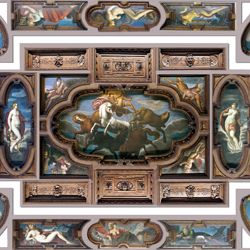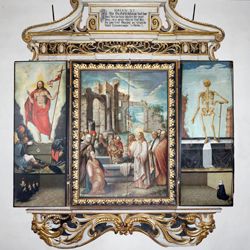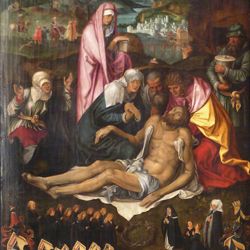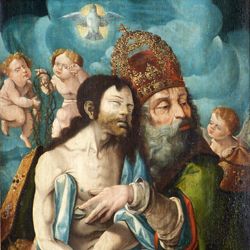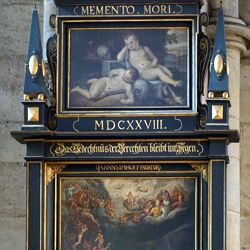Georg (Jörg) d. J.
Gärtner (Gertner, Hortulanus)
painter, etcher
christened Nürnberg, 16. Jun 1577
buried Nürnberg, 20. Feb 1654
Son of George the Elder Ä.; Father of Christopher and George Paul, all painters. ∞ I) October 21, 1594 Magdalena (died February 7, 1572 – died December 31, 1611), daughter of Bartholomew Bauer (Agricola), deacon at the Holy Spirit, eight children; II) September 2, 1612 Ursula (died August 13, 1591 – died April 30, 1652), daughter of Hans Pfister, bookbinder, eleven children. Training with his father. He became a master before the painters' regulations were introduced in 1596, so that he did not have to submit a sample. Until his father's death in 1612, he probably ran a joint workshop with him on Schwabenberg. He signed in the same way as his father, so that the works before 1612 cannot always be clearly separated. 1620-24 and 1638-42 predecessor of the painting trade. According to Stüwe, on a series of 44 etchings depicting the funeral procession of Margrave Georg Friedrich of Brandenburg, it is noted: “At Nuremberg by Georgen Gärtner the disciples / in the Newengassen / published and made in a truck / 1603”. He also wrote a graphic sheet with the five consequences of drunkenness. In 1609/10 he painted ceiling paintings for Martin Peller for the so-called Pellerhaus on Egidienplatz. Gärtner also provided templates for the illustrations for “Hortus Eystettensis” by Basilius Besler, published in 1613. In 1613 he worked with his sons Hieronymus and Christoph and together with Paul Juvenell the Elder. Ä., Jobst Harrich and Gabriel Weyer on the restoration of the town hall hall. He was also described by contemporaries as a skillful imitator of Dürer1. On behalf of the Nuremberg Council, he copied its Four Apostles, the originals and the copies were given as a gift to Elector Maximilian I of Bavaria, the copies were returned to Nuremberg. The Württemberg preacher Johann Valentin Andreae also owned copies of Dürer. He probably also painted the epitaph from 1624 for Willibald Imhoff the Elder. Ä. in the Rochus Chapel, which also shows Dürer copies. A portrait of Bartholomäus Viatis at the age of 86 is in the GNM. Panzer recorded another portrait of Viatis by Gärtner, which served as a model for an engraving by Andreas Kohl; The storage location of the painting depicted by Pfeiffer is unknown today. A third portrait, which Gärtner painted by Viatis, was in Hanff's collection and was offered for sale to the city in 1859. Gärtner trained the following apprentices: Wolf Vischer (1596-1600), Hans Motschenbacher (1601-1604), Michel Koch (1605-08), Christoph Halter (1618-23). In the case of Christoph David Eimmart it is unclear whether he worked with Georg d. in 1594-98. Ä. or d. J. was trained, the apprenticeship probably took place in the shared workshop. On January 20, 1615, Gärtner and his second wife bought a house opposite the Rosenbad (Schildgasse 11) for 900 florins. He does not seem to have lived here for long, as he changed address twice until 1628. In 1628 he found a permanent home in the city's alms mill (Mühlgasse 1-3), for which he paid 24 fl. a year in rent. When he defaulted on the interest due to the bad times of the Thirty Years' War, half of the debt was forgiven, and from July 1, 1640 the rent was reduced to 18 fl. Gärtnerstrasse in Nuremberg was named after him and his father. His daughter Anna Maria married the painter Nicolaus Baudenbacher on October 17, 1638, and his daughter Margaretha married the painter Johann Christoph Götz on November 3, 1648. Works: NUREMBERG, Rochus Chapel: Dürer's foundation plaque (epitaph for Willibald Imhoff), dated 1624. MuS: NUREMBERG, GNM: Portrait of Bartholomew I. Viatis. Lit.: AKL; Thieme Becker; Nagler, KL and Monogr.; Doppelmayr, 1730; Baroque, 1962; Stüwe, 1998, pp. 41, 231; Tacke, 1995, pp. 195-197; Tacke, 2001, p. 408 and family tables 18, 92; City lexicon 2000; Kohn, NHb Sebald. Exhibit: 1952/5. (quoted from the Nuremberg Artists' Lexicon, edited by Manfred H. Grieb) ___________________ 1 In a list of Nuremberg painters dated August 13, 1615, Georg Gärtner the Younger mentions reported: Albrecht Dürer copied his wife very cleanly. (Note: GNM Archive Painter No. XII/44, fol. 10v.) in: The “Beautiful Room” from the Pellerhaus, Dieter Büchner, 1995, p. 297, text and note. The Württemberg theologian Johann Valentin Andreae described Gärtner as a skillful imitator of Dürer (“felicissimus Düreri imitator”)
Style: Early Baroque, Late Renaissance
